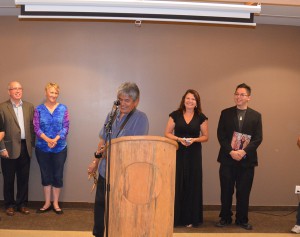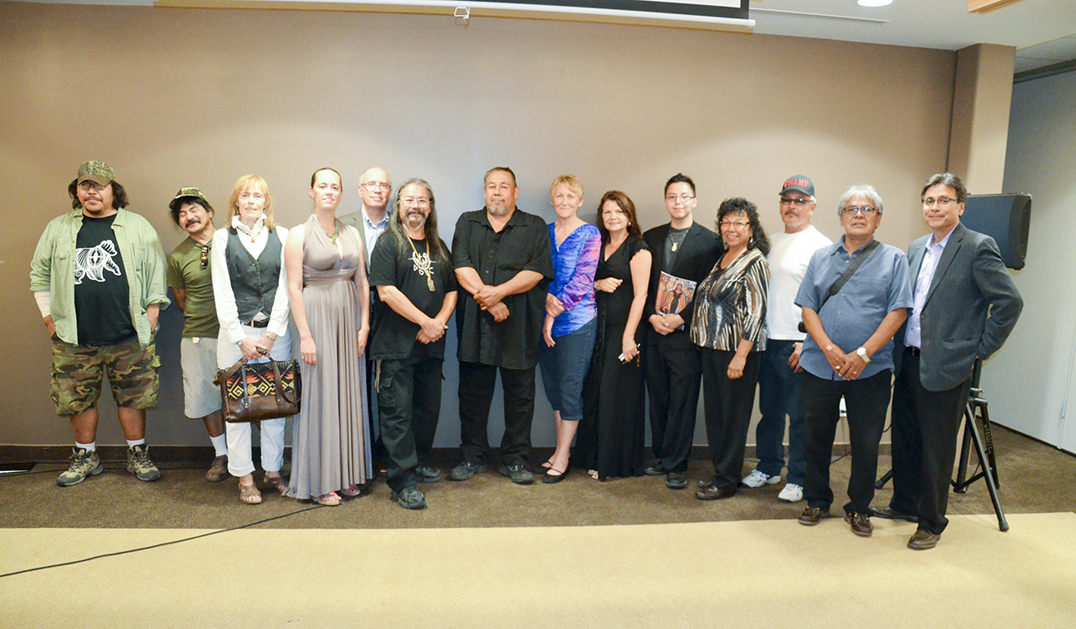LITTLE CURRENT— A unique opportunity to explore the gamut of contemporary Anishinaabe art is currently available (until August 17) at the Manitoulin Hotel and Conference Centre in Little Current. Displayed within the main conference room are outstanding original works of art by 30 of the most celebrated and talented artists with Manitoulin Island connections in existence.
The unique opportunity afforded by ‘From the Heart of Turtle Island: Contemporary Art from Manitoulin Island’ should not be missed by anyone who has an interest in art. Among the artworks can be traced the development of much of the Eastern Woodland Style of art, as well as the innovative and challenging creations of artists who have their own unique styles.
“This exhibition comprises paintings, drawings, prints and other works of art made by artists who currently live and work on Manitoulin Island, or on the mainland surrounding it,” said exhibit spokesperson Peel Art Gallery, Museum and Archives curator Tom Smart in his curatorial statement. “Many of the artists are living, some have passed away.”
“In Anishinaabemowin there is not a word for ‘art’,” noted co-curator Mike Cywink. “When we speak about art, we are referring to the expression through colour, concept and design as a way of allowing the spirits to share their message with the message carrier. In this case the messenger carriers are indigenous artists.”
“The purpose of the exhibit is to show and interpret the range of artistic expression by these artists,” continued Mr. Smart. “As you will see, their work deals with the land and people associated with Manitoulin Island. Other themes relate to recent history and to the distant past, the time before contact was made with the Europeans and to the ancient time described in the creation legend. Many also explore the present times as it affects them and their families.”

The exhibit also celebrates the work of an entire generation of artists who came to national and international notice in the 1970s, he said. “Names like Francis Kagige, Daphne Odjig, Martin Panamick, Blake Debassige, Leland Bell, Randy C. Trudeau, Carl Beam, James Simon Mishibinijima, John Laford, Peter Migwans, and Shirley Cheechoo, among others.”
Three key themes pervade the exhibit, according to Mr. Smart. “The first involves the interpretation of history and legend surrounding the creation story of Turtle Island, the second theme explores the conditions of living on the Island and of the difficult past many have suffered owing to the residential schooling, economic hardship, racism, poverty and abuse; the third theme is associated with the spiritual aspects of living on the Island—this involves feeling a very close affinity to and being part of the entire creation.”
Mr. Smart noted that there is very little curatorial commentary in the exhibit. This is deliberate, he said. “In this way, we hope that the overall theme of the exhibition can be understood as clearly as possible.” It is the curatorial teams’ hope that the exhibit will “inspire transformative experiences in you, as it has for the artists presented in this exhibit.”
During the gala opening of the exhibit members of the Fielding and Wallace families were in attendance, as well as a veritable who’s who of the Island and Sudbury art scene along with a significant number of national and international patrons of the arts.
Characteristically low key, representatives of the Wallace and Fielding families were unwilling to make statements to the media on the production, wishing to leave the significance of the event to the curatorial team and those organizing the event. Family members did note privately, however, that their hope in supporting this exhibit is to raise the profile of local indigenous artists to their rightful place in the index of the globe’s creative pantheon and, perhaps more prosaically, to enable those artists to find broader markets for their works to enable them to better support themselves and to continue to work and create their unique and inspiring works.

Anishinaabe historian Dominic Beaudry of Wikwemikong gave a short history of the land and its people at the podium during the opening gala for the exhibit, Chief Shining Turtle of Whitefish River First Nation discussed the important role that artists play within the community and culture of First Nations communities, and Wikwemikong Chief Duke Peltier noted that this exhibit embodies the very spirit of why the First Nation communities built the Manitoulin Hotel and Conference Centre in the first place. Chief Peltier expressed a sentiment that was largely shared in the room. “I hope this becomes an annual event,” he said.
Artist Leland Bell spoke on behalf of the artists, noting that the 2015 Woodland Art Exhibit is dedicated to the memory of Francis Kagige (1929-2014), Lynda Pitawanakwat (1964-2015), Josh Peltier (1979-2015) and Randy C. Trudeau (1954-2013).
Mr. Bell expressed another lifelong dream that he has deeply held, along with many leading figures in the art community, that an art school could be established on Manitoulin Island. Mr. Bell referenced the art camps of the 1960s and 1970s on Schreiber Island that played a seminal inspirational role in the careers of his own and many other local artists.
The lenders to the exhibit included the families of Francis Kagige, Randy C. Trudeau, Josh Peltier, and Lynda Pitawanakwat, as well as Ten Mile Point, the Whitefish River First Nation and many of the artists themselves.
Special acknowledgements were given to Austin Flamand, Robert Pheasant and CreativeEFX Advertising.
The curatorial team team for the exhibit are Tom Smart curator of the Peel Art Gallery, Museum and Archives, Mike Cywink curator of the Wiikemikoong Art Gallery, Nikki Manitowabi of the Wikwemikong Development Corporation, Mark Seabrook tourism coordinator of the Ojibwe Cultural Foundation and Anne Benness former board member of the Art Gallery of Sudbury.
Partners and sponsors of the exhibit included the Fielding Family, Pioneer Construction Ltd., Fisher Wavy Inc., the Ojibwe Cultural Foundation, the Wiikemikoong Art Gallery, the Wikwemikong Development Corporation, the Wikwemikong Board of Education and the Peel Art Gallery, Museum and Archives.
The show runs until August 17 at the Manitoulin Hotel and Conference Centre and is open to the public from 10 am to 6 pm. The show will move on from the Manitoulin Hotel and Conference Centre to be displayed at the Peel Art Gallery, Museum and Archives before returning home to be exhibited at the Debajehmujig Art Gallery and the Ojibwe Cultural Foundation at dates to be announced.





